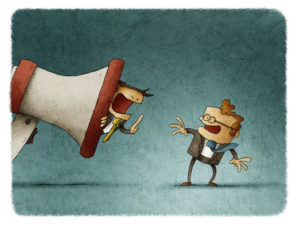Imagine that it’s the good old days, and we’re enjoying ourselves at a busy conference with noise and signs and huddles and laughter everywhere.
As we pass each other, my mind deep in thought, I accidentally trip you, and you crash to the floor. What is the right thing for me to do? Keep walking and not look back? Defend that it wasn’t my fault because I didn’t mean to? Point and laugh?
Read more: Creating Confusion or Comprehension? The Ethical Imperative for Behavioral Engagement.Polite society and ethics agree that it is my immediate responsibility to apologize and help you up. Anything less would be downright uncivilized.
What are we to do when people “trip” on our communication?
Do we have an ethical responsibility when communication triggers confusion? Conventional teaching says if we’ve done our market research and done our best, we have fulfilled our ethical obligation. But does that still hold true today?
The field of behavioral communication suggests our responsibility is evolving because of how science is redefining our understanding of human cognition and decision-making.
Tuned for 100% of the Mind
As professional communicators, we are taught to engage the conscious mind with rational strategies, words, and tactics. When we conduct research, most of what is available to us draws on insights from questioning the conscious mind, such as surveys and focus groups.
However, in the last 20 years, behavioral and cognitive scientists have proven the nonconscious mind is responsible for an alarmingly large amount of information processing, managing a whopping 95 to 99 per cent of decision-making. Instead of being an audience we can ignore, the nonconscious mind is inextricably involved in making sense and making decisions around a communicator’s golden assets: words, messages, and requests.
With as much as 99 per cent of decision-making occurring in the nonconscious, is it ethical to leave knowledge of what this mind prefers out of our work? Is it ethical to create communication that is known to make the nonconscious mind trip and fall flat on its face?
Bias and Nonconscious Stumbling Blocks
Our mind’s use cognitive bias shortcuts to rapidly assess, filter, categorize, react, and respond to information. The trouble for rational, intellectual communication methods is that these biases deviate from rational judgment. Hundreds of these biases work together in our nonconscious to create our individual realities.
Daniel Kahneman, the first social psychologist to win a Nobel Prize, is one of the researchers behind the ground-breaking swell of behavioral and cognitive research reshaping how we understand the human mind. In Thinking, Fast and Slow, he details the differences between conscious and nonconscious processing and how the mind takes shortcuts to handle all the often-overwhelming amount of information we encounter every day.
A well-known cognitive bias is social proof, a phenomenon wherein people look to their social circles for proof of how to behave. Social proof is increasingly used in communication strategies, but sometimes with disastrous consequences because the communicator only has a fractional understanding of how the nonconscious mind considers information.
One example of social proof messaging going terribly wrong was experienced by one of the largest insurance providers in the U.S. Following the advice of their celebrated messaging agency, they led with the message, “84 per cent of American’s are not saving enough for retirement.” The message was the hero on the website, the lead in all customer communication, and the primary PR angle. And it didn’t work. Product interest, coverage, leads, conversions, and sales plummeted. Why?
Because despite successfully engaging the conscious and nonconscious together – this message reversed the bias in a way that made it work against them. Just as we nonconsciously look to society to tell us what to do, we also look at it to tell us what not to do.
Presenting societal proof in this negative framework screamed to the audience, NO ONE SAVES FOR RETIREMENT AND YOU SHOULDN’T EITHER!
Did the communicators who crafted that message fulfill their ethical responsibility? Despite doing so inadvertently, these communicators manufactured rejection. Behavioral communication argues that to do so before was a forgivable error.
But as we complete more and more of the map of conscious and nonconscious communication preferences, to continue to make these mistakes is the equivalent of tripping someone in the hall and insisting it’s not your fault because you didn’t mean to.
Behavioral Engagement and Communication
The mind is a fascinating and complex place, and we are at an incredibly exciting moment in history. We can tune communication to succeed more so than any generation before us.
Many of the constructs we held as true in communication are changing because of behavioral and cognitive science research, and a whole new toolkit for successful engagement is emerging. As such, we have an ethical imperative as professional communicators to expand our awareness and skills to positively engage the conscious and nonconscious mind. It is our responsibility to ensure our strategies and words create comprehension rather than confusion.
In an age of so much chaos and mis- and dis-information, the world is counting on its communicators, storytellers, speechwriters, and the like to help us make sense, and make our way through.
























